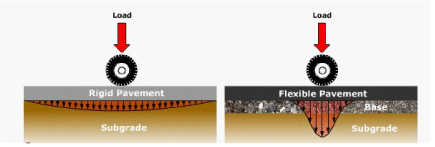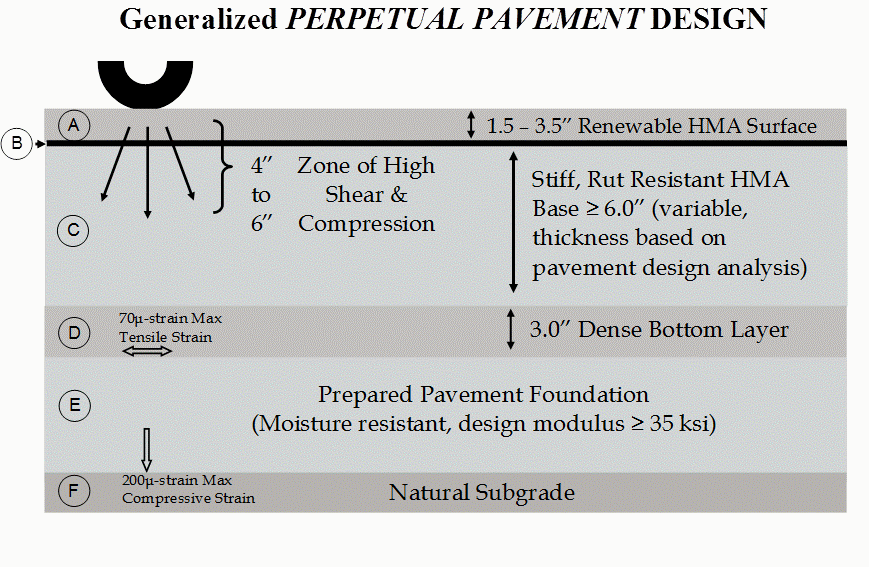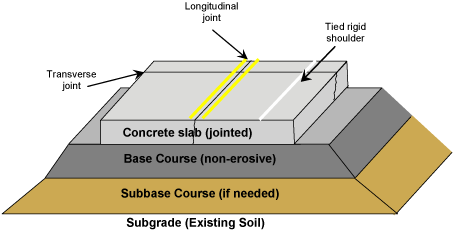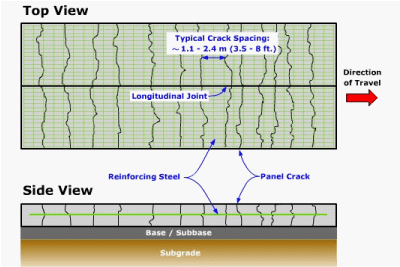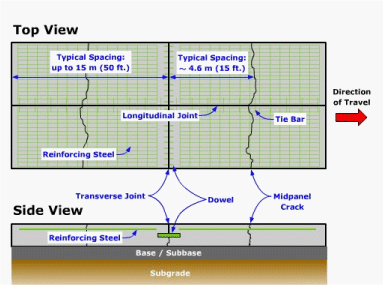Section 4: Pavement Types
Anchor: #i10083204.1 Rigid and Flexible Pavement Characteristics
The primary structural difference between a rigid and flexible pavement is the manner in which each type of pavement distributes traffic loads over the subgrade. A rigid pavement has a very high stiffness and distributes loads over a relatively wide area of subgrade – a major portion of the structural capacity is contributed by the slab itself.
The load carrying capacity of a true flexible pavement is derived from the load-distributing characteristics of a layered system (Yoder and Witczak, 1975). Figure 2-1 shows load distribution for a typical flexible pavement and a typical rigid pavement.
Figure 2-1. Typical stress distribution under a rigid and a flexible pavement.
Anchor: #i10083464.2 Flexible Pavement
A flexible pavement structure is typically composed of several layers of material with better quality materials usually placed on top where the intensity of stress from traffic loads is high and lower quality materials at the bottom where the stress intensity is low. Flexible pavements can be analyzed as a multilayer system under loading.
A typical flexible pavement structure consists of the surface course and underlying base and subbase courses. Each of these layers contributes to structural support and, ideally, maintains proper drainage.
When hot-mix asphalt (HMA) is used as the surface course, it typically is the stiffest (as measured by elastic modulus) layer and may contribute the most (depending upon thickness) to pavement strength. The underlying layers are less stiff but are still important to pavement strength as well as drainage and frost protection.
Thicker HMA sections and or sections with stabilized bases behave as a semi-rigid system under traffic loading, whereby loads are spread to a greater degree over the natural subgrade than conventional flexible pavements. See “Rigid and Flexible Pavement Characteristics” above.
When a seal coat is used as the surface course, the base generally is the layer that contributes most to the structural stiffness. A typical structural design results in a series of layers that gradually decrease in material quality with depth. Figure 2-2 shows a typical section for a flexible pavement.
Figure 2-2. Typical section for a flexible pavement.
Anchor: #i10083894.3 Perpetual Pavement
Perpetual pavement is a term used to describe a long-life structural design. It uses premium HMA mixtures, appropriate construction techniques, and occasional maintenance to renew the surface. Close attention must be paid to proper construction techniques to avoid problems with permeability, trapping moisture, segregation with depth, and variability of density with depth. A perpetual pavement can last 30 years or more if properly constructed and maintained.
In conventional flexible pavements, structural deterioration typically occurs due to either classical bottom-up fatigue cracking, rutting of the HMA layers, or rutting of the subgrade. Perpetual pavement is designed to withstand an almost infinite number of axle loads without structural deterioration by limiting the level of load-induced strain at the bottom of the HMA layers and top of the subgrade and by using deformation-resistant HMA mixtures. Figure 2-3 shows a generalized perpetual pavement design.
Figure 2-3. Generalized perpetual pavement design.
Anchor: #i10084164.4 Rigid Pavement
A rigid pavement structure is composed of a hydraulic cement concrete surface course and underlying base and subbase courses (if used). Another term commonly used is Portland cement concrete (PCC) pavement, although with today’s pozzolanic additives, cements may no longer be technically classified as “Portland.”
The surface course (concrete slab) is the stiffest layer and provides the majority of strength. The base or subbase layers are orders of magnitude less stiff than the PCC surface but still make important contributions to uniformity of support, pavement drainage, and frost protection, and provide a working platform for construction equipment.
Rigid pavements are substantially ‘stiffer’ than flexible pavements due to the high modulus of elasticity of the PCC material, resulting in very low deflections under loading. The rigid pavements can be analyzed by the plate theory. Rigid pavements can have reinforcing steel, which is generally used to handle thermal stresses to reduce or eliminate joints and maintain tight crack widths. Figure 2-4 shows a typical section for a rigid pavement.
Figure 2-4. Typical section for a rigid pavement.
Anchor: #i10084534.5 Continuously Reinforced Concrete Pavement
CRCP provides joint-free design. The formation of transverse cracks at relatively close intervals is a distinctive characteristic of CRCP. These cracks are held tightly by the reinforcement and should be of no concern as long as the cracks are uniformly spaced, do not spall excessively, and a uniform non-erosive base is provided. Figure 2-5 shows a typical section of CRCP.
Figure 2-5. Continuously Reinforced Concrete Pavement (CRCP).
Anchor: #i10084744.6 Concrete Pavement Contraction Design (CPCD)
CPCD uses contraction joints to control cracking and does not use any reinforcing steel. An alternative slab design designation used by the industry is jointed concrete pavement (JCP). Transverse joint spacing is selected such that temperature and moisture stresses do not produce intermediate cracking between joints. Nationally, this results in a spacing no longer than 20 ft. The standard spacing in Texas is 15.0 ft.
Dowel bars are typically used at transverse joints to assist in load transfer. Tie bars are typically used at longitudinal joints. Figure 2-6 shows a typical section of CPCD.
Figure 2-6. Concrete Pavement Contraction Design (CPCD).
Anchor: #i10085014.7 Jointed Reinforced Concrete Pavement (JRCP)
JRCP uses contraction joints and reinforcing steel to control cracking. Transverse joint spacing is longer than that for concrete pavement contraction design (CPCD) and, in Texas, it typically ranges from 30 ft. to 60 ft. This rigid pavement design option is no longer endorsed by the department because of past difficulties in selecting effective rehabilitation strategies. However, there are several remaining sections in service. Figure 2-7 shows a typical section of jointed reinforced concrete pavement.
Figure 2-7. Jointed Reinforced Concrete Pavement (JRCP).
Anchor: #i10085234.8 Post-tensioned Concrete Pavements
Post-tensioned concrete pavements remain in the experimental stage, and their design is primarily based on experience and engineering judgment. Post-tensioned concrete has been used more frequently for airport pavements than for highway pavements because the difference in thickness results in greater savings for airport pavements than for highway pavements.
Anchor: #i10085354.9 Composite Pavement
A composite pavement is composed of both hot-mix asphalt (HMA) and hydraulic cement concrete. Typically, composite pavements are asphalt overlays on top of concrete pavements. The HMA overlay may have been placed as the final stage of initial construction, or as part of a rehabilitation or safety treatment. Composite pavement behavior under traffic loading is essentially the same as rigid pavement.
